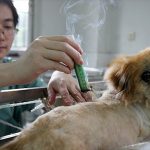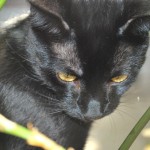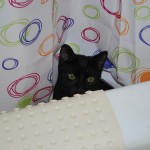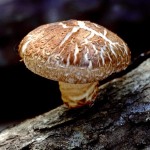Progressive Retinal Atrophy In Dogs

Let’s talk about Canine Progressive Retinal Atrophy (PRA):
I’ve spent my summer taking some new classes in animal health. So, I’m going to share a few things I’ve learned about Veterinary Ophthalmology. I won’t make it too complicated, but to give you some hope that there are natural treatments for cat and dog eye diseases.
Progressive Retinal Atrophy (PRA):
To understand what is PRA, let’s first describe how the eye works: The eye is made up of components of the fundus (interior surface of the eye). From the outside, in of the eye, is the sclera, the choroid (which is the vascular that feeds the outer retina), the retina, tapetum/Non tapetum, and the optic nerve.
The retina is a thin veil with blood vessels. The function of the retina is to take whatever it is you are looking at and transform electromagnetic radiation (visible light) into an electrochemical signal that can be interpreted by the brain. NOTE: Under examination, the retina looks different from dog to dog. And, from just looking at the retina, you can tell the color of the fur, whether it’s long coat or short, or a large or small breed dog.
There are 10 layers to the neural retina and 3 neuron chains. The neuron chain I’m going to discuss now are the photoreceptors: rods (dim light, movement) and cones (bright light, color, acuity). Animals don’t see in the acuity. But, nonetheless, they do have some. In the eye disease Progressive Retinal Atrophy (PRA) it is the photoreceptors that degenerate.
Are Certain Dog Breeds Affected By PRA?
PRA is a lump term for many inherited retinal degenerative diseases affecting numerous breeds of dogs, both purebred and mixed. It used to be only pure breeds, but because of designer dogs where purebreds are mixed together, the recessive genes can often become expressed.
In PRA, the majority of dogs have a mutation in the rods and this causes them to lose their night vision first. Often owners miss “night blindness” in their dogs simply because with smaller dogs they are always being carried from place to place, or either the dogs are always with their owners while the lights are on and not outside in the dark where a problem can be noticed.
Often, PRA isn’t suspected until the dog suddenly becomes easily spooked or refuses to go down the stairs (because he can’t see the stairs). By the time this occurs it might mean the dog has had PRA for quite some time. If the owner misses the “night blindness” the disease will progress to when the dog goes outside in the sunlight, and then comes back inside to dimmer light, the dog’s eyes will have difficulty adjusting.
Eye Health & Anti-oxidants
The ratio of rods to cones is 20:1. So, if all the rods start dying then you’re left with a sparse number of cones which are now exposed to an excess amount of oxygen. Thus, they begin to die from oxidative stress. This will cause a gradual loss of day vision, and then blindness.
Because of all this oxidative stress there is an imbalance of glutathione. Glutathione is an anti-oxidant that is found in the eye, the brain, and in the liver, and protects the cones from oxidative stress. Other anti-oxidants that can help the dying cones would be a combination of Lutein/Zeaxanthin and Alpha lipoic acid. A recent study of mice with RD (retinal degeneration) disease were given a blend of anti-oxidants and it stopped the retina from dying, and hence, the mice were able to maintain their sight for the rest of their lives (providing they stayed on the supplements for the rest of their lives).
Food Source Of Anti-Oxidants
Lutein is present in the retina, and in higher amounts in the peripheral retina, and a little bit in the iris and lens. A supplement food source of Lutein/zeaxanthin can be found in marigolds and in egg yolks. A typical egg yolk will contain 6mg of Lutein, but organic grass-fed eggs will have a slightly higher number. Diets supplemented with Lutein significantly enhances cell-mediated and humoral immunity in dogs, and this gives Lutein a potent anti-inflammatory effect.
Alpha lipoic acid is a water-and fat-soluble antioxidant and is made in the body. Food sources would be Brewer’s yeast and organ meats. Alpha lipoic acid regenerates Vitamin C, Vitamin E, and CoQ10 into their original states so they can be effective again. And, Alpha lipoic acid increases the body’s production of glutathione, and glutathione is important because it protects the cones. NOTE: High doses of lipoic acid can be toxic to cats. So, be careful with supplements: Read study.
Other anti-oxidants excellent for eye health are: Grape Seed Extract, Green Tea Extract, Vitamin E, and CoQ10. NOTE: Vitamin E given alone becomes a free-radical, so it must be taken with Vitamin C or Grape Seed Extract.
This is the end of Part One. In a few weeks I’ll continue with my discussion on eye diseases in cats and dogs. Next Topic: The Diabetic Cataract.










